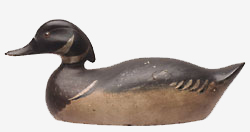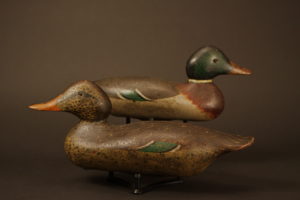The Mason Decoy Factory of Detroit, Michigan has been held as the standard of factory decoys for many years. Mason decoys are the most famous factory made decoys. Mason produced decoys from 1888 to 1894 and then from 1903 to 1924. Early Mason decoys were hand carved wood; later lathe-turned products were produced in five different grades. Hundreds of thousands of Mason Decoys were produced and shipped to all parts of the U.S. Most were used by hunters in the Midwest, however! According to old advertisements, Masons could originally be purchased by the dozen for $12-24 shipped in a wooden crate. The best and most detailed decoys were called “premiere” grade, followed by the Challenge grade, standard glass eye, tack eye grade and finally painted eye models. There are more Mason decoys sitting around in living rooms and in collections than any other decoy made in the country.
Mason decoys exhibit an artistry and skill in their paint patterns along with unique brush swirls in early examples. Their paint seemed to weather extremely well and many have original paint to this day. Mason decoy values are becoming out of reach for many new collectors and prices vary widely. Most of them are unmarked and sell for a few hundred dollars but prices can go into the thousands depending on condition, grade and species. A Mason, premiere grade wood duck sold for $354,000 at an auction in 2000 and was later sold in 2014 for $690,000!

This Mason Premier Grade wood duck drake, ca. 1905, sold at auction in 2000 for $354,500, an auction record for a Mason decoy and the sixth highest price ever paid for any waterfowl decoy at auction. This decoy sold for $690,000 in an April, 2014 auction. Photo: RJG Antiques.
A beginning value range for collectible, common Mason duck decoys would be $700-$1200 for most decent birds with original paint. It is still possible to find unmarked Mason decoys in antique stores and auctions without them being identified. Of course, before you purchase a decoy be sure to consult an expert for help in positive identification.
More information on Mason decoys can be found in Byron Cheevers, 1974 book Mason Decoys. History and values taken from “North American Factory Decoys” by Kenneth Trayer and “Warmans Duck Decoys” by Russell E. Lewis.

